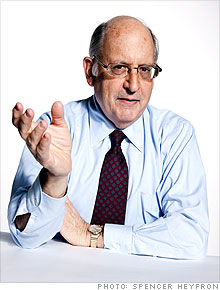Search News
FORTUNE -- One of the best pieces of advice I ever got was from a former editor, who told me how to handle topics that were likely to annoy the powerful. "Don't nibble at their toes," he told me. "Go for their throat."
That's why I'm renaming the financial reform bill known as Dodd-Frank, to what it really is: the Toe-Nibbling Act of 2010.

The reason is that, with a rare exception or two, this 2,000-page bill nibbles at the toes of the problems that brought us the worldwide financial meltdown. It doesn't go for the throat -- its sponsors just pretend that it does.
Yes, Dodd-Frank may be, as President Obama calls it, "the toughest financial reform since the ones we created in the aftermath of the Great Depression." If that's the case, the bill shows how narrow our ambitions have become, and how little history we know.
Contrast Dodd-Frank with the legislation that emerged after the Great Depression, and you see the difference between nibbling and throat-biting. The aftermath of the Great Depression brought us federal deposit insurance, which ended the bank runs that had wiped out the savings of millions of people overnight. It brought us the Securities and Exchange Commission, which made financial markets accessible to all; the Glass-Steagall Act, which broke up the nation's biggest and most powerful financial institutions; and Social Security, which assured retirees that they wouldn't starve in their old age.
Systemic problems survive
By comparison, the only possibly transformative element in Dodd-Frank is the consumer protection agency. And the only hope for that agency -- set to be theoretically independent but housed in the Federal Reserve -- is to get a powerful, aggressive, efficient director who can navigate institutional and legal obstacles. That would get the agency off to a running start and guarantee its effectiveness for years, before it inevitably succumbs to what sociologists call "regulatory capture." That's when regulators end up being heavily influenced by the industries they oversee.
Sure, there are some useful things other than consumer protection in Dodd-Frank. But assuming the bill becomes law in its current form, we'll have the same systemic problem we had when the meltdown started in June 2007: too many institutions that are too big to fail, and a perilously opaque financial system that will freeze if problems recur.
At least half a dozen big institutions -- Goldman Sachs (GS, Fortune 500), Morgan Stanley (MS, Fortune 500), J.P. Morgan Chase (JPM, Fortune 500), Wells Fargo (WFC, Fortune 500), Bank of America (BAC, Fortune 500) and Citigroup (C, Fortune 500) -- are way too big and too interconnected to be allowed to go under. All except Morgan Stanley and Citi have emerged bigger and more powerful from the three-year meltdown.
One reason markets froze in the summer and fall of 2008 was that big institutions became afraid to make short-term loans to one another, largely because they lacked the information they needed to gauge the financial situations of would-be borrowers. In some cases, these giant institutions couldn't even figure out their own situations.
We've talked before about how to fix those problems, and most of the elements I've suggested are not in the bill. Surprise! So, I'll say it again. Institutions need to have a lot more capital to keep them from failing. They need to have books that are transparent, with derivatives and other esoterica trading on public exchanges. And we need to have a government-related entity sponsor publicly accessible, real-time databases so investors can value the collateral underlying mortgage-backed securities and other asset-backed paper. (I also wanted the directors and executives of these institutions to be more at risk, but that was never going to happen.)
I don't know the ins and outs of Washington lawmaking, and don't particularly want to learn them. Life is too short. But two distinctive noises told me what I needed to know about Dodd-Frank. The first was the sigh of relief on Wall Street, which ran financial stocks up sharply when the final version of Dodd-Frank was unveiled on Friday. The second was the sound of toes being nibbled. ![]()






| Company | Price | Change | % Change |
|---|---|---|---|
| Ford Motor Co | 8.29 | 0.05 | 0.61% |
| Advanced Micro Devic... | 54.59 | 0.70 | 1.30% |
| Cisco Systems Inc | 47.49 | -2.44 | -4.89% |
| General Electric Co | 13.00 | -0.16 | -1.22% |
| Kraft Heinz Co | 27.84 | -2.20 | -7.32% |
| Index | Last | Change | % Change |
|---|---|---|---|
| Dow | 32,627.97 | -234.33 | -0.71% |
| Nasdaq | 13,215.24 | 99.07 | 0.76% |
| S&P 500 | 3,913.10 | -2.36 | -0.06% |
| Treasuries | 1.73 | 0.00 | 0.12% |
|
Bankrupt toy retailer tells bankruptcy court it is looking at possibly reviving the Toys 'R' Us and Babies 'R' Us brands. More |
Land O'Lakes CEO Beth Ford charts her career path, from her first job to becoming the first openly gay CEO at a Fortune 500 company in an interview with CNN's Boss Files. More |
Honda and General Motors are creating a new generation of fully autonomous vehicles. More |
In 1998, Ntsiki Biyela won a scholarship to study wine making. Now she's about to launch her own brand. More |
Whether you hedge inflation or look for a return that outpaces inflation, here's how to prepare. More |